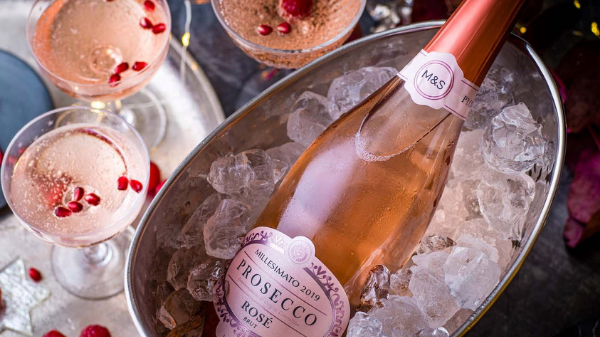Your favourite colour and your favourite drink have a baby. In the Instagram-fuelled, novelty-seeking world, the result has success written all over it.
Some wines are masterpieces of science, intuition and magic; others are feats of marketing and intelligent branding. Prosecco rosé drives the market in the second category.

As a rosé recruit and not a fan of pinkifying things, I had pre-conceived notions about this sparkly peachy drink. It came across a fussy middle child of the grape family. Not sophisticated enough to be red, not airy enough to be white. But the pandemic happened and it shook the drinking landscape. The tide shifted; cocktail culture flourished; wine-appreciation intensified. After the tumult that was 2020, the dawn of 2021 demanded a new drink – something celebratory, chilled and cheerful, a crowd-pleaser – Prosecco rosé ticked all the right boxes. The misunderstood offspring splashed onto the global drinking scene and affixed its crown. Bottomless brunches everywhere around the world just got an upgrade.
Lady In Pink

It’s hard to believe that pink Prosecco is a new thing.
Prosecco with its fruity sparkly profile has become enormously popular in the last decade. To explain “enormously popular”, in 2018 the drink which took the brunch world by rage, sold more bottles than Champagne for the first time in modern history. The growth has been unstoppable since then.
Rosé with its bright pastel, floral and moreish appeal is Instagram gold – it’s a day drink, one with a tang of the exotic, evoking long, boozy lunches, conjuring fantasies of yachts and posh beach holidays. No one sips Rosé in run down cafes or dreary office parties. It represents a very liberal, lavish, trust-fund lifestyle and who doesn’t pine for that.

Marry the two wines and it’s a marketing dream –it’s like selling the Champagne lifestyle on a Gatorade budget. But till October 2020, rosé and Prosecco were not allowed to mingle, that’s when the Prosecco DOC Consortium in Italy, updated its rules and officially allowed the two hottest drinks of the planet to merge. Prosecco rosé hit the bar shelves and ice buckets in January 2021.
There was no dearth of sparkling pink wines in the marke. In fact, more than half of Italy’s 350 Prosecco producers have unofficially been toying with the pink version for years but tight EU regulations meant that none could be labelled Prosecco, only white wines were allowed to bear the title. So, this is all very exciting for Prosecco fans.
Also Read: Alcoholiday – The unstoppable rise of herb-infused, alcohol-free spirits
Marketing Dream, Not a Gimmick

Prosecco is a wine region in North-eastern Italy and the style of fizzy wine made from the Glera variety of grapes. The best produce comes from the traditional belt in the Conegliano-Valdobbiadene area and even though it’s not a patch on the chicness and complexity of Champagne (that would be an unfair comparison!), the finer varieties of Prosecco have a fresh briskness, lightness, a soft charm all it’s own.
The official decree mandates that true Pink Prosecco must maintain a strict production criteria –
- It should be made from 85% white Glera’s variety of grapes, blended with a maximum of 10-15% of the red Pinot Noir grapes to give it that intensely beautiful salmon hue which patrons find irresistible.
- The secondary fermentation process must take place by in a tank by the Charmat method for a minimum of 60 days to introduce carbonation (that’s twice the amount required for regular Prosecco).
- The final product can only be Brut Nature (very dry) or Extra Dry (actually sweeter) styles and vintage-dated.
- The Consortium suggests up to 30 million bottles be produced annually from the 2019 or the 2020 harvest, that means one in every 16 bottles of prosecco on the shelves will be rosé.

The alcohol content is a modest 11% – won’t make you feel guilty for opening a bottle for a Monday lunch or buying into that ‘Rosé All Day’ lexicon. Cin-cin!
(Text – Nikita Mishra)
Also Read: A Taste for Teetotallers: Our favourite non-alcoholic spirits



